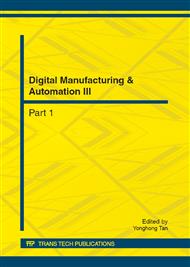[1]
U. Meier, O. Lopez, C. Monserrat, M. C. Juan and M. Alcañiz. Real-time deformable models for surgery simulation: a survey, Computer Methods and Programs in Biomedicine, vol. 77, 2005, p.183.
DOI: 10.1016/j.cmpb.2004.11.002
Google Scholar
[2]
M. Müller, J. Dorsey, L. Mcmillan, R. Jagnow and B. Cutler. Stable real-time deformations, InProc SCA, 2002, pp.49-54.
DOI: 10.1145/545261.545269
Google Scholar
[3]
J. Barbic and D. L. James. Real-time subspace integration for st. venant-kirchhoff deformable models, " In SIGGRAPH, 05: ACM SIGGRAPH 2005 Papers, New York, USA, 2005, pp.982-990.
DOI: 10.1145/1186822.1073300
Google Scholar
[4]
R. Kikuuwe, H. Tabuchi, and M. Yamamoto. An edge-based computationally efficient formulation of saint venant-kirchhoff tetrahedral finite elements, ACM Trans. Graph., vol. 28(1), 2009, pp.1-13.
DOI: 10.1145/1477926.1477934
Google Scholar
[5]
G.R. Joldes,A. Wittek, M. Couton, S.K. Warfield and K. Miller. Real-time prediction of brain shift using nonlinear finite element algorithms, Proceedings of MICCAI 2009, Springer-Verlag, Berlin, Heidelberg, 2009, pp.300-307.
DOI: 10.1007/978-3-642-04271-3_37
Google Scholar
[6]
G.R. Joldes, A. Wittek and K. Miller. Suite of finite element algorithms for accurate computation of soft tissue deformation for surgical simulation, Medical Image Analysis, vol. 13, 2009, pp.912-919.
DOI: 10.1016/j.media.2008.12.001
Google Scholar
[7]
F. Conti, O. Khatib and C Baur. Interactive rendering of deformable objects based on a filling sphere modeling approach, 2003, pp.14-19.
DOI: 10.1109/robot.2003.1242167
Google Scholar
[8]
S. Wang, G. Yang and W. Chou. Soft body compound deformation algorithm with dynamics correction, Computer Engineering, vol. 20, (2011).
Google Scholar
[9]
J. Louchet, X. Provot, and D. Crochemore. Evolutionary identification of cloth animation models, Computer Animation and Simulation, 1995, pp.44-54.
DOI: 10.1007/978-3-7091-9435-5_4
Google Scholar
[10]
K. S. Bhat, C. D. Twigg, J. K. Hodgins, P. K. Khosla, Z. Popovic, and S.M. Seitz. Estimating cloth simulation parameters from video, Proc. ACM SIGGRAPH/Eurographics Symp on Computer Animation, 2003, pp.37-51.
Google Scholar
[11]
G. Bianchi, B. Solenthaler, G. Székely, and M. Harders. Simultaneous topology and stiffness identification for mass-spring models based on FEM reference deformations, Proc. Medical Image Computing and Computer-Assisted Intervention, vol. 2, 2004, pp.293-301.
DOI: 10.1007/978-3-540-30136-3_37
Google Scholar
[12]
B. A. Lloyd, G. Szekely, and M. Harders, Identification of spring parameters for deformable object simulation, IEEE Transactions on Visualization and Computer Graphics, vol. 13, 2007, pp.1081-1094.
DOI: 10.1109/tvcg.2007.1055
Google Scholar
[13]
Y. Zhong, B. Shirinzadeh, G. Alici, and J. Smith. A cellular neural network methodology for deformable object simulation, IEEE Transactions on Information technology in Biomedicine, vol. 10, 2006, pp.749-762.
DOI: 10.1109/titb.2006.875679
Google Scholar
[14]
P. Korbelt and K. Sloti. Modeling of elastic internode bounds in cellular neural network-based implementation of the deformable grid paradigm, International Workshop on Cellular Neural Networks and Their Applications, Istanbul, Turkey, vol. 10, 2006, pp.1-6.
DOI: 10.1109/cnna.2006.341612
Google Scholar
[15]
O. Deussen, L. Kobbelt, and P. Tucke. Using simulated annealing to obtain good nodal approximations of deformable objects, Computer Animation and Simulation, 1995, pp.30-43.
DOI: 10.1007/978-3-7091-9435-5_3
Google Scholar
[16]
H. Courtecuisse, H. Jung, J. Allard, C. Duriez, D. Y. Lee and S. Cotin. GPU-based real-time soft tissue deformation with cutting and haptic feedback, Progress in Biophysics and Molecular Biology, Vol. 103, 2010, pp.159-168.
DOI: 10.1016/j.pbiomolbio.2010.09.016
Google Scholar
[17]
TetGen, http: /tetgen. berlios. de.
Google Scholar


